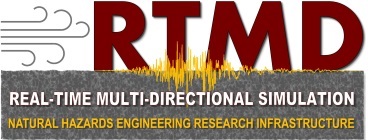Testing on passive damping systems
February 18, 2011
The vision for this research is a validated probabilistic, performance-based seismic design procedure for buildings with passive damping systems. Tests at the Lehigh NEES equipment site will characterize the dampers; analytical models for the dampers will be calibrated and validated.
Large-scale, real-time hybrid simulations at the Lehigh NEES equipment site will validate the rigorous assessment procedure as well as the results of the practical performance-based design procedure. The hybrid simulations will have two phases: Phase 1 uses three individual large-scale dampers as the lab specimens, while the remainder of the building is modeled as an analytical substructure; Phase 2 uses a large-scale, three-story steel frame with dampers as the lab specimen, while the remainder of the building is modeled as an analytical substructure.
Full-scale damper characterization test data sets will be produced. Validated analytical models for passive dampers, suitable for numerical simulations, will also be produced. Reliable and well-documented data sets from large-scale, real-time hybrid seismic simulations of buildings with passive dampers will be produced and used to validate the design and assessment procedures.


